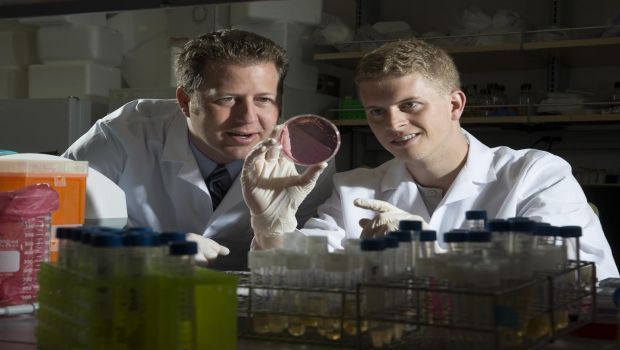Scientists Use Bacteriophages to Treat MRSA
Senior molecular biology major Jacob Hatch knows MRSA as the infection that took his dad's leg. Hatch was thousands of miles away on an LDS (Mormon) mission when methicillin-resistant Staphylococcus aureus decalcified the bones in his dad's foot and lower leg, leading to an emergency amputation just below the knee.


Dr. Brad Berges and undergraduate Jacob Hatch are researching ways bacteriophages can attack and kill MRSA. Hatch's father (and Berges' father-in-law; same person) contracted MRSA a few years ago and lost a limb because of it. Photo courtesy of Mark A. Philbrick/BYU Photo
Senior molecular biology major Jacob Hatch knows MRSA as the infection that took his dad's leg. Hatch was thousands of miles away on an LDS (Mormon) mission when methicillin-resistant Staphylococcus aureus decalcified the bones in his dad's foot and lower leg, leading to an emergency amputation just below the knee.
"It was really hard to hear the news--you never expect to hear someone in your family having to have a limb amputated," Hatch says. "I felt helpless being so far away."
Now Hatch is exacting revenge on the bacteria. Researching alongside assistant professor of microbiology and molecular biology (and brother-in-law) Bradford Berges, Hatch is unlocking the power of a new MRSA-killer: bacteriophage.
Phages are viruses that seek out, infect and kill bacteria. BYU researchers have successfully used them to save beehives from American foulbrood, and now they are harnessing their abilities to find MRSA and eliminate it.
In a recent study published in high-ranking journal PLOS ONE, Hatch, Berges and colleagues demonstrate the ability of phages to kill human MRSA bacteria from both hard surfaces (glass table top) and fabrics (lab coat).
The findings on phage effectiveness against MRSA are increasingly vital since the deadly bacterium is now resistant to almost all available antibiotics. Doctors worry that the one antibiotic that can still treat MRSA--vancomycin--may soon be ineffective as well.
MRSA is most problematic in hospitals and nursing homes--places where the sick and wounded are susceptible to infection. Berges said about 30 percent of humans are carriers for the bacteria, but it only "gets nasty" when it penetrates the skin.
People who are infected can develop sepsis, pneumonia, meningitis or even die. Fortunately, Berges and Hatch's research is showing that phages kill more than 99 percent of MRSA pathogens.
"And while phages kill off bacteria, they will never cause any problems to humans because it's a virus that's evolved to infect bacteria cells," Berges says. "It's never going to infect human cells--it's not even a possibility."
To date, the research team has identified six unique phage types that can kill off MRSA. Their future research will identify even more MRSA-killing phages.
Thanks to the mentoring of Berges, Hatch has now published as an undergraduate student and is in prime position for medical school next year. He hopes his work can prevent others from the challenges his dad has faced.
"This research is my way of coping with it and feeling like I've been able to do something to solve these type of problems," Hatch says. "It's been so rewarding to see that it is working."
Source: Brigham Young University
Show, Tell, Teach: Elevating EVS Training Through Cognitive Science and Performance Coaching
April 25th 2025Training EVS workers for hygiene excellence demands more than manuals—it requires active engagement, motor skills coaching, and teach-back techniques to reduce HAIs and improve patient outcomes.
The Rise of Disposable Products in Health Care Cleaning and Linens
April 25th 2025Health care-associated infections are driving a shift toward disposable microfiber cloths, mop pads, and curtains—offering infection prevention, regulatory compliance, and operational efficiency in one-time-use solutions.
Phage Therapy’s Future: Tackling Antimicrobial Resistance With Precision Viruses
April 24th 2025Bacteriophage therapy presents a promising alternative to antibiotics, especially as antimicrobial resistance continues to increase. Dr. Ran Nir-Paz discusses its potential, challenges, and future applications in this technology.